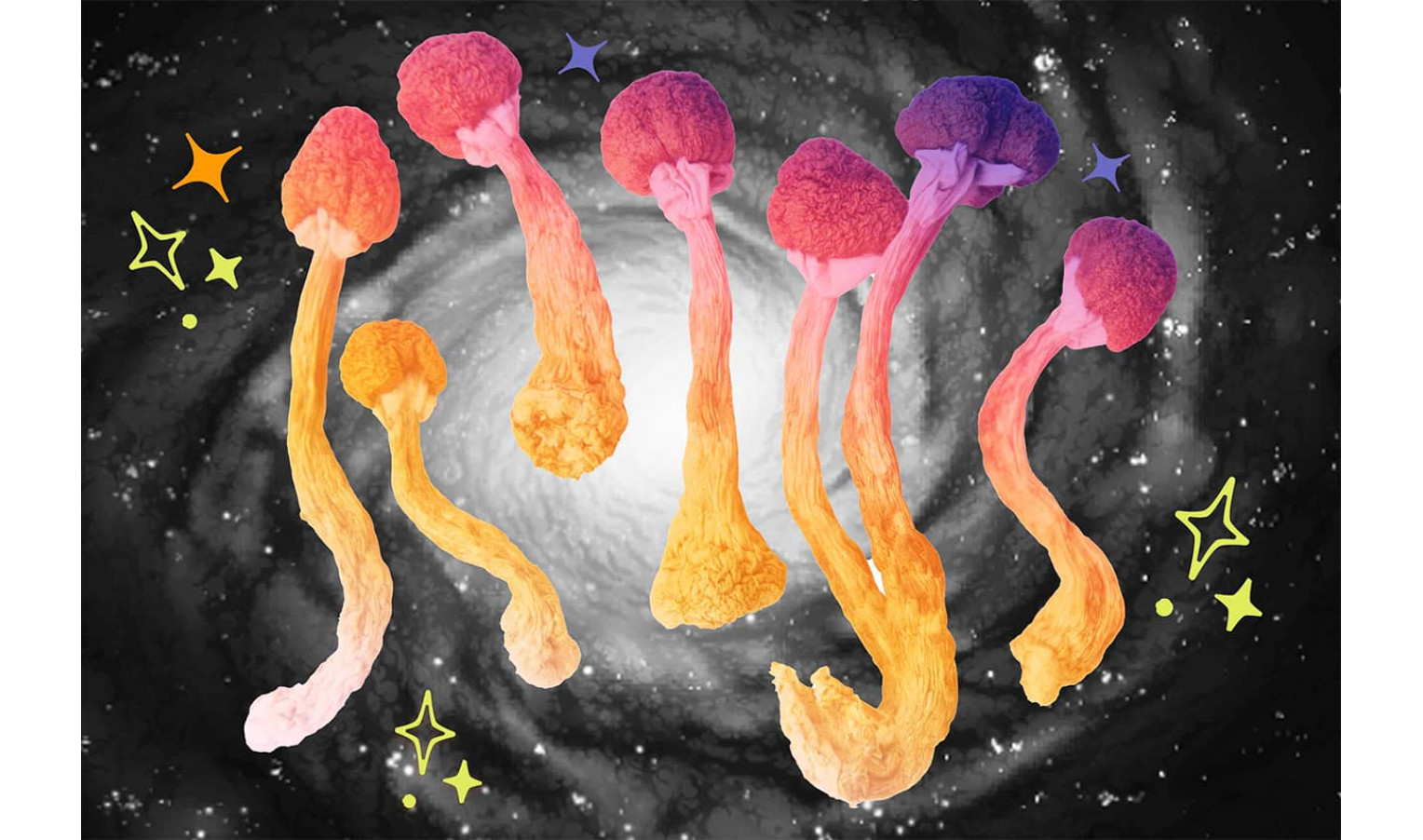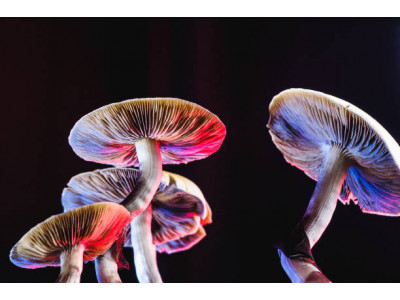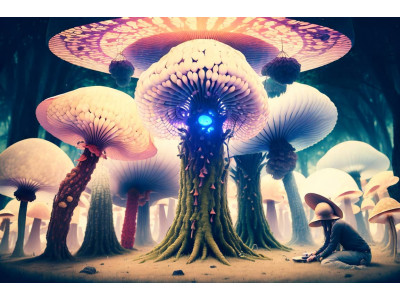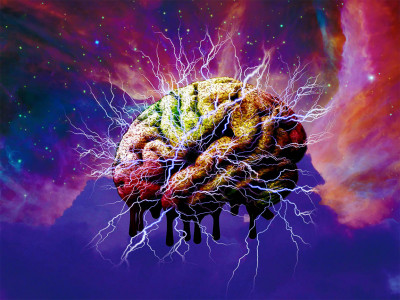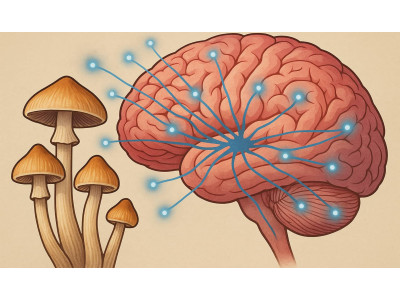Types of psilocybin mushrooms
Contents
- Introduction
- Historical background
- Psilocybin mushrooms
- Psilocybin mushroom chemistry
- Safety of taking psilocybin
- Legal aspect
- Mushroom spores
- List of references
- FAQ
Introduction
***WARNING: The author of this article does not encourage the use of psilocybin mushrooms and reminds about the importance of responsible attitude to the law. All information provided is for informational purposes only.***
Magic mushrooms have been known to mankind since its earliest days on earth. Since the dawn of history, they have accompanied man right up to the present day, invisibly but tangibly present in many areas of our lives. As in any
cosmic scenario, the subject of mushrooms is initially shrouded in mystery and mysticism. Throughout history, mushrooms have been attributed magical and medicinal properties and some have attributed the nature of magic mushrooms to God himself! Terence McKenna's hypothesis about the connection between magic mushrooms and the evolution of the early human brain - the Stoned Ape Theory. And what about the well-known biblical scenarios of Adam and Eve's expulsion from the Garden of Eden. the Garden of Eden (with new details), where the reason Adam realized he was Adam was not an apple, but a magic mushroom? The Aztecs called these mushrooms "teonanacatl" - "body of the god", and only the chosen and initiated consumed it. Rituals involving the use of hallucinogenic mushrooms have survived among Central American tribes right up to the present day.
Statuettes in the shape of mushrooms
created by the Mayans.
There are about thirty thousand recorded species of fungi that are capable of producing fruiting bodies (mushrooms). About one hundred species or varieties are known to contain psilocybin or related compounds such as psilocin , beocystin and norbeocystin Most of these are found in the genera Psilocybe and Panaeolus, and some are found in other genera, such as Inocybe, Conocybe, Gymnopilus and others. Of course, not all mushrooms in these genera or families contain psilocybin, and even those that do may produce it often produce it only in trace amounts. Since different species of psilocybin mushrooms contain different levels of alkaloids, therefore the dosage needed varies. This should always be taken into account when exploring new species.
Historical Background
The 20th century of our history is gradually dispelling the fog of mysticism surrounding the subject of psychedelic mushrooms. Psilocybin mushrooms were researched from the 1950s through the 1970s by several prominent scientists, including Timothy Leary and Richard Alpert of Harvard University. They described the mind-expanding properties of the mushrooms, which are somewhat similar to synthetic drugs such as LSD . However, the widespread recreational use of these mushrooms has prompted state and federal governments to strictly control them in many places.
The brilliant minds of the past, scientists, doctors, philosophers, and artists are getting involved in the research.The topic of psychedelics is beginning to take shape. Discoveries and breakthroughs in chemistry, biology, neuroscience, psychology, etc. are taking place. Albert Hoffman's discovery of the psychoactive properties of LSD in the middle of the last century becomes a kind of starting point for formal research and application of psychedelics. There's a lot of public
research, conferences, investments. The isolation of pure psilocybin by Hoffman in 1958 also belongs to this period. And then there's an unprecedented the hippie movement, the echoes of which can still be heard quite clearly in different parts of the world today. In a nutshell, it's hard to even to cover all the current trends in the development of this trend, it is only appropriate to emphasize the globality and reality of the scale. In the 21st century, psilocybin mushrooms have been tested as a treatment for chronic mental disorders such as anxiety, depression, addiction and post-traumatic stress disorder (PTSD). In the United States, the Department of Veterans Affairs is testing psilocybin and psilocin to reduce mental health problems in veterans and suicide rates. While scientists are still trying to understand how these mushrooms alter brain function, some findings suggest that their active components may have the ability to break down old neural connections and create new ones, potentially reducing negative or obsessive thinking and allowing patients to develop more positive behaviors and a view of the world in general.
Psilocybin mushroom species
Psilocybe Cubensis
Psilocybe cubensis is the most widely cultivated species of psychoactive mushroom for historical and biological reasons. Worldwide, it is one of the most common psilocybin-containing species found in the wild, and,
therefore among the most commonly used and best known species. It is also one of the easiest to cultivate, as it fruits on a wide range of substrates and under a variety of environmental conditions. Although in the
wild it grows exclusively on manure, when cultivated it will fruit on almost any type of substrate rich enough in carbon and nitrogen: cereal straw, on grain, on grass, even on wood chips, paper or cardboard if
they are supplemented with some form of protein or sugars.
Most mushroom species, are quite finicky in their substrate requirements and condition for fruiting, but not Psilocybe cubensis. This fact, combined with its rather large amount of psychoactive substances, makes it one of the
of the best mushroom species for the novice cultivator. We recommend starting your introduction with Psilocybe cubensis because it is the easiest to grow, and it is also the type of mushroom that contains psilocybin that people are most familiar with. Its fast-growing, rhizomorphic mycelium, abundant primordia, large fruiting bodies, and abundant spore production have all made it the most typical representative among magic mushrooms that are easy to grow at home. Only after you have been able to gain experience in growing this mushroom and familiarized with its life cycle, you will be ready to work with species that behave more "capricious".
Psilocybe cubensis is a tropical and subtropical mushroom that grows in abundance on the manure of cattle, horses and horses or on soils containing their manure. It can be found almost anywhere in the world with humid and warm climates, including Southeast Asia and Australia, India, Mexico, Central America, northern South America and the Caribbean. It is one of the largest psilocybin-containing species, with a cap size of 5 to 15 centimeters in diameter and a thick stalk up to 20 centimeters long. When grown on grain or rice it is usually modest in size, but on manure or compost it can produce huge, even colossal-sized mushrooms. The spore print, is often "fat" and consists of purplish-brown spores.
Psilocybin mushrooms, how to tell the difference?
When a Psilocybe cubensis mushroom is "traumatized," it often leaves "bruises" or blue spots on its fruiting body. Although, this reaction to injury, which yields blue spots, often indicates the presence of psilocybin in the mushroom, such blueing alone does not can be considered definitive proof, as there are other species of mushrooms that lack psilocybin but give exactly the same reaction with "blueing". Furthermore, the absence of a blueing reaction does not necessarily rule out the the presence of psilocybin-like alkaloids in the mushroom. The blueing reaction occurs when psilocin (or some other chemical agent) is oxidized into a yet-to-be-explained dark blue chemical compound. Mushrooms containing low levels of psilocin but significant levels of psilocybin will not turn blue, despite their apparent psychoactivity.
Psilocybe cubensis is considered moderately potent compared to other psychoactive mushroom species. It can contain up to 1.2% (dry weight) psilocybin, psilocin, and beocystin, averaging somewhere around 0.5% or 0.5 mg/gram. While such averages are useful milestones for comparing the efficacy of one species with another, it is important to keep in mind that activity can vary widely among mushrooms of the same strain. Certain strains, or the same strain grown under different conditions or on different substrates, can exhibit dramatic differences in activity. Even the same strain can vary in its psychedelic properties from one harvest wave to the next, with the second and third harvest waves usually being the strongest.
There are species of Psilocybe that like wood as a substrate. Although Psilocybe cubensis is very easy to grow, there is one type of home cultivation to which it is ill-suited: outdoors. In nature, of course, it grows outdoors, and it can certainly be grown in a garden or park, but only if you have the right latitude. The two main advantages of creating a "mushroom bed" in the garden are that it can be either a perennial crop or a "secret" garden. You plant a mushroom bed in a hard-to-reach place, remember it until it starts to bear fruit, then harvest the mushrooms, and then "forget" about it again until the fruiting process is repeated the following year.
Once a secret mushroom bed has been established, that bed should be a more or less a self-sustaining system and completely invisible except when it is fruiting. Psilocybe cubensis is not suitable for growing in an outdoor "mushroom bed" for a number of reasons. First of all, it fructifies fairly quickly and continuously until its substrate is depleted of nutrients, and its mycelium is not capable of living long enough to be considered perennial. Secondly, this fungus grows and fecundates on a wide variety of substrates, but also a variety of other undesirable macroorganisms and microorganisms can reside in such a substrate. Unless the secondary substrate is sterile (or at least unusually clean), it will become infested with mold and bacteria long before the fungus can fully develop. This is why it is almost always grown indoors under very carefully controlled conditions.
Finally, being a tropical species, it does not grow well in cooler climates and certainly cannot tolerate the below freezing temperatures that characterize many places having winter months. Fortunately for the mushroom cultivator, there are a number of other species available Psilocybe that are up to the task. These include primary saprophytes or fungi that grow on dead wood, a group of psilocybin-containing fungi that are able to grow on wood chips or bark mulch and, due to their appearance, are all collectively known as "psilocybe mushrooms" and are collectively known as "caramel caps". This group includes up to 10 species, including Psilocybe cyanescens, P. azurescens and P. cyanofibrillosa, which are all native to the Pacific Northwest of the United States. There are Eastern European Psilocybe species, such as P. Serbica and P. bohemica, as well as Psilocybe subaeruginosa and P. tasmaniana, which are native to Australia and New Zealand.
Psilocybe cyanescens
Psilocybe cyanescens is a moderately vigorous species commonly found in the Pacific Northwest, from San Francisco to Canada. Its most distinctive feature is the wavy edge of the cap, which is what gives the mushroom the nickname "wavy caps". It grows on wood chips or wood debris in lawns, piles and along mulched paths. While the mushroom is young it has a conspicuous "spidery" partial veil that quickly disintegrates at maturity. P. cyanescens has a relatively high psilocin content and quickly "turns blue" when injured.
Psilocybe azurescens
Psilocybe azurescens is the most potent known mushroom of the Psilocybe genus. It is similar in appearance to P. cyanescens, except that it lacks the wavy border at the end of the cap, and often has a pronounced "nipple" in the center of the
of the cap, a feature known as an umbrella cap. In nature, it usually grows on woody debris in sandy coastal soils, often under grasses in dunes. P. azurescens has a particularly high beocystin content, which may account for its supposedly unique psychedelic "signature". People who have used it usually report that it produces deep and potent "vision" effects without significant physical discomfort.
Psilocybe semilanceata
Semilanceata grow in various regions of the world, including Ukraine. They prefer moist and shady places, often growing on decaying organic matter such as fallen leaves and tree litter. They are widespread in western Ukraine in mountainous areas. The mushrooms are small in size, characterized by a conical cap with a convex center and a bluish tint. At maturity, the cap may become flatter and the color changes from light brown to olive-brown.
Psilocybin mushroom chemistry
The chemical compounds found in Psilocybe mushrooms are a complex of related tryptamine compounds containing an indole ring and an amine linked by a two-carbon chain. All of these compounds are closely related to the common amino acid L-tryptophan, from which the mushroom builds them, and to serotonin (5-hydroxytryptamine), a major neurotransmitter in mammals, which helps explain their pharmacological effects on humans.
Psychedelic alkaloids found in Psilocybin Mushrooms
Psilocin and its phosphate ester psilocybin are the most common compounds found in these mushrooms, while baeocystine and norbeo(norbao-)cystine are usually present only in trace amounts, if at all. Psilocybin is rapidly converted in the body to psilocin by removing its phosphate group, making the two compounds more or less identical in efficacy and psychedelic effects despite their different molecular weights. The psychoactive effects of baeocystin and norbaeocystin (in isolation) are not well understood, but there is some evidence that they modulate the psychoactive effects of psilocin and psilocybin. Their presence in varying amounts may help explain reports of subjective differences from one species of psilocybe mushroom to another.
No doubt due to the many legal obstacles to public scientific study of these mushroom species, almost nothing concrete is known about why these chemicals are present in these mushrooms in the first place. Nature rarely does anything without a practical purpose, especially when the action is energetically costly, as is certainly the case here. These compounds must serve some evolutionary advantage for the survival of these species of fungi in nature. Otherwise, the resources that go into synthesizing them would be better spent, for example, on creating more spores or larger fruiting bodies. One could argue that these molecules ensure the survival of these species of fungi because their presence encourages people to grow and propagate them for their psychoactive effects. However, this logic makes no sense in nature, as these fungi have been doing just fine for millions of years without our help and have been growing on their own long before the advent of humans. The chemicals they contain must have had some important purpose in their daily struggle to survive in their natural environment.
How exactly psilocybin produces its psychedelic effects, which it does on the human brain, is still a mystery, both because of the profound complexity of our brain functions and because of the legal restrictions placed on the study of
psychedelic molecules. Nevertheless, its main effect is believed to be mainly the result of its interaction with certain serotonin receptors. Neurobiologists refer to two general types of active molecules: agonists and antagonists.
An agonist binds to a receptor with an effect similar to the actual neurotransmitter, whereas an antagonist blocks the action of the neurotransmitter. Returning to the "lock and key" metaphor, an agonist is a key that fits and opens a lock,
like a lock pick, though perhaps with greater or lesser efficiency than the neurotransmitter itself, while the antagonist works simply like a key inserted into a lock, preventing the actual key from entering the lock itself. It is believed
that psilocybin and related molecules are serotonin agonists. They bind to receptors and act on them in the same way as serotonin, but with a slightly different effect. While the effect on each individual receptor may be small, their overall effect on the human mind is undeniably profound...
The safety of taking psilocybin
Given the powerful psychedelic effects on humans one might reasonably wonder if the compounds found in Psilocybe mushrooms could somehow be be toxic to human brain health in any way. In fact, there is no evidence that they are toxic at all. First of all, they are unlikely to be toxic given that they have such a long history of human use without a single attributed death. Furthermore, these molecules have been repeatedly subjected to traditional toxicology tests, which have shown them to be fairly harmless. Psilocybin has an LD-50 (or 50% lethal dose) of about 280 mg/kg in rats and mice, which means you need to give test animals 280 milligrams of psilocybin for every kilogram of body weight, to kill half of them. Roughly speaking, what this means for humans is that an adult male with an average weight of 80-kilograms would need to eat 22 grams of pure psilocybin or something like 500 grams of dried Psilocybe cubensis mushrooms to earn a a 50% chance of death! By comparison, caffeine, which is widely considered a "beneficial nervous system stimulant" for humans, has an LD-50 in rats of 192 mg/kg, making it about 1.5 times more "toxic" than psilocybin.
Psilocybin mushrooms how much to eat?
It is very conventional to draw some kind of abstract boundary between levels of psychedelic effect. Consider the gradation of levels of psychedelic effect. Quantities are given in grams of properly freshly dried mushroom, Golden Teacher strain P.Cubensis species.
LEVEL 1 ~ 0.1 - 0.9 GRAMS. (MICRODOSING)
Minimal and / or not noticeable changes in perception. The nature and structure of thoughts changes, and it becomes possible to track them in a new way. The topic of microdosing is very actively studied in the scientific environment and practiced by many people in everyday life. Microdosing is used more for recreational and research purposes. (including medical) purposes.
LEVEL 2 ~ 1 - 2.5 GRAMS.
An entry level psychedelic trip.Clearly observable changes in perception, yet fully controlled. A level suitable for communication and shared experiences, including open spaces. Bodily, mental (mental), earthy level of trip.
LEVEL 3 ~ 3 - 4.5 GRAMS.
Became the benchmark amount of mushrooms, the golden mean of the psychedelic experience. Significant changes in perception of space, time, events, one's role. All sorts of earthly and cosmic themes are observed and experienced. The conscious control of these levels of tripping opens up incredible possibilities for programming of reality (imprinting of the nervous system, brain). The level of borderline state of awareness of the body form and its limits. The ability to look beyond the boundaries of reality while remaining in it. Cellular, bioelectrochemical level of the trip.
LEVEL 4 ~ 5 - 7 GRAMS.
A deep psychedelic experience. Perception of reality can change to the point where "no trace of the familiar world remains." The experience of awareness beyond the usual form of the body, living the lives of other people and beings, the experience of traveling in time and parallel versions of multidimensional reality, the ability to step out of reality, to experience the so-called "exit from the matrix", to realize oneself as the beginning, the end and the cause of all events and phenomena. The experience of dying, events after death and new birth.
LEVEL 5 ~ 10+ YRS.
OUT SPACE. Taking that many mushrooms is comparable to skydiving, not knowing if the parachute itself is in the backpack. This depth of tripping is an attempt to experience the "ultimate experience of reality". And sometimes it does succeed. However, few people have been able to describe such experiences in human language. A dangerous experience for most unprepared beings. Nevertheless, it's an extremely resourceful experience for those who are able to navigate these depths. The opportunity to realize and experience the experience of God himself, to travel through the multiverse, living entire universes and creating new ones, the absolute loss of any possibility of control over anything. Merging of consciousness with reality.
Legal aspect
Currently psilocybin-containing mushrooms are among the prohibited substances in Ukraine. Mycelium is also prohibited for distribution. However, spore prints are allowed for distribution because spore prints do not contain any psychoactive substances. All this information is informative and does not call for action.
Mushroom spores
Golden teacher
Golden Teacher is one of the most common of the so-called "strains" of Psilocybe cubensis species mushrooms. They have been the most popular option among beginners and experienced alike for decades and are often considered the top choice to this day. The original Golden Teacher specimen, collected in the late 70's, is believed to originate from the Mexican Gulf Coast region of the United States. These mushrooms are known for their "mild" character and are often considered the benchmark for comparing the effectiveness of different strains of magic mushrooms.
Albino A+.
White and tall fruiting bodies with a delicate shade of gray on the cap. These mushrooms grow up to 20 cm tall and form cluster families of 3-6 specimens. The spores are dark brown in color. They colonize the substrate relatively quickly, but cannot always be classified as high-yielding strains. Their pearly pale coloration may conjure up associations with "poisonous" mushrooms, but this impression is deceptive.
PF Red Spore
Unlike the classic PF strain, PF Red Spore mushrooms produce red-colored spores. Robert McPherson, also known as "Psilocybe Fanaticus", developed this strain in the 1990s when he discovered a mutation in the classic PF strain resulting in red spores. PF Red Spore is one of 100 different strains of Psilocybe cubensis. Contrary to the similarities with other strains, PF Red Spore has its own specialty. It is very easy to grooving and is capable of producing good yields.
Pink Buffalo
According to legend, the spores of these magic mushrooms were found in a field inhabited by pink buffalo (according to Thai legend, meeting a pink buffalo promises good luck). This strain of Psilocybe cubensis grows in humid climates and tends to give medium to large sized fruits. The caps range from 25 to 75 mm in diameter and are colored in reddish-brown or brown shades. Sometimes the caps can be very pale cream or white in color. The stalks reach a length of 125 to 175 mm and are yellowish colored
Jedi Mind Fuck
Jedi Mind Fuck appeared in the early 2000s and is a relatively new hybrid mushroom strain inspired by the Star Wars concept. The strain's unique name is attributed to its strong effects and deep reflexivity, which can be so intense that the mushrooms seem to temporarily take over a person's mind and emotions. That said, according to the Auckland Psilocybin Cup, the mushroom belongs to the medium, non-strong strains. JMF is not as resistant to infestation as some other beginner-friendly varieties and requires more attention.
List of references
1. Stamets, P. (1996). Psilocybin Mushrooms of the World: An Identification Guide. Ten SpeedPress.
2. Guzmán, G. (1983). The Genus Psilocybe: A Systematic Revision of the Known Species Including the History, Distribution and Chemistry of the Hallucinogenic Species. Beihefte zur Nova Hedwigia, 74, 1-492.
3. Allen, J. W., & Merlin, M. D. (1992). Psychoactive mushrooms of the Pacific Northwest. Journal of Psychoactive Drugs, 24(2), 161-176.
4. Gartz, J. (1994). Ecology and cultivation of hallucinogenic mushrooms. Integration, 5, 13-17.
5. Guzmán, G., & Allen, J. W. (1995). A Worldwide Geographical Distribution of the Neurotropic Fungi, an Analysis and Discussion. Annali del Museo Civico di Rovereto, 11, 189-280.
6.Johnson, M. W., & Griffiths, R. R. (2017). Potential Therapeutic Effects of Psilocybin. Neurotherapeutics, 14(3), 734-740.
7.Nichols, D. E. (2004). Hallucinogens. Pharmacology & Therapeutics, 101(2), 131-181.
Vollenweider, F. X., & Kometer, M. (2010). The neurobiology of psychedelic drugs: implications for the treatment of mood disorders. Nature Reviews Neuroscience, 11(9), 642-651.
8.Carhart-Harris, R. L., & Goodwin, G. M. (2017). The therapeutic potential of psychedelic drugs: past, present, and future. Neuropsychopharmacology, 42(11), 2105-2113.
Johnson, M. W., & Griffiths, R. R. (2017). Potential Therapeutic Effects of Psilocybin. Neurotherapeutics, 14(3), 734-740.
FAQ
How to distinguish psilocybin mushrooms?
To be sure that a psilocybin mushroom found in nature is psilocybin mushroom, it is necessary to have knowledge of mycology and experience in collecting wild mushrooms. A blueing reaction when the stalk is broken may indicate the presence of psilocin, but is not a guarantee. Some poisonous substances also turn blue when oxidized. Determining the species or genus of psilocybin mushroom, however, can be done if you have access to the right literature with photos of all known species.
Psilocybin mushroom species
There are two main genera of psilocybin containing mushrooms. These are Psilocybe and Panaeolus. Panaeolus and Psilocybe are the genera. Cyanescens and Cubensis are species. And species have varieties, i.e. strains. For example, Psilocybe species Cubensis has strains Golden Teacher, Tapalpa, Pink Buffalo, Thai and many others.
Psilocybin mushrooms Ukraine species
Only 1 species of psilocybin mushrooms grows on the territory of Ukraine. Psilocybe Semilanceata. This species is widespread in western Ukraine in mountainous areas. The mushrooms are small in size, characterized by a conical cap with a convex center and a bluish tint. At maturity, the cap may become flatter and the color changes from light brown to olive-brown.

